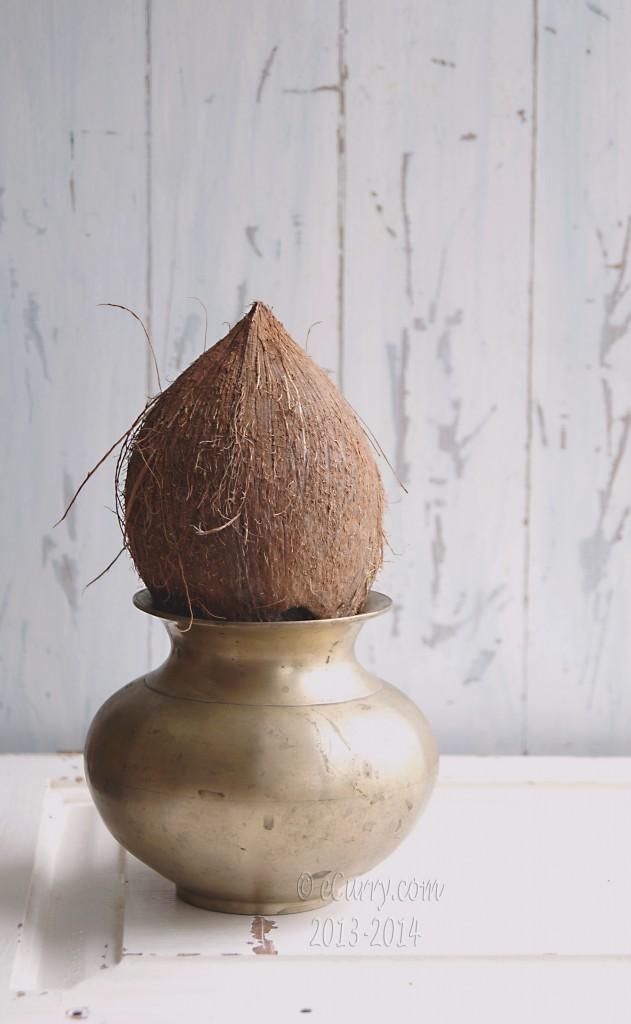
Coconut is loved, honored and revered in India.
I grew up in a land where coconut trees are in abundance. Last time when I visited home, the tall towering trees with green long swaying leaves I viewed from the airplane window immediately started an untold story in my heart; memories flooded back, that warm, fuzzy feeling of homecoming had begun. Coconut has indoctrinated into the fabric of life, culture and customs of the South Asians.
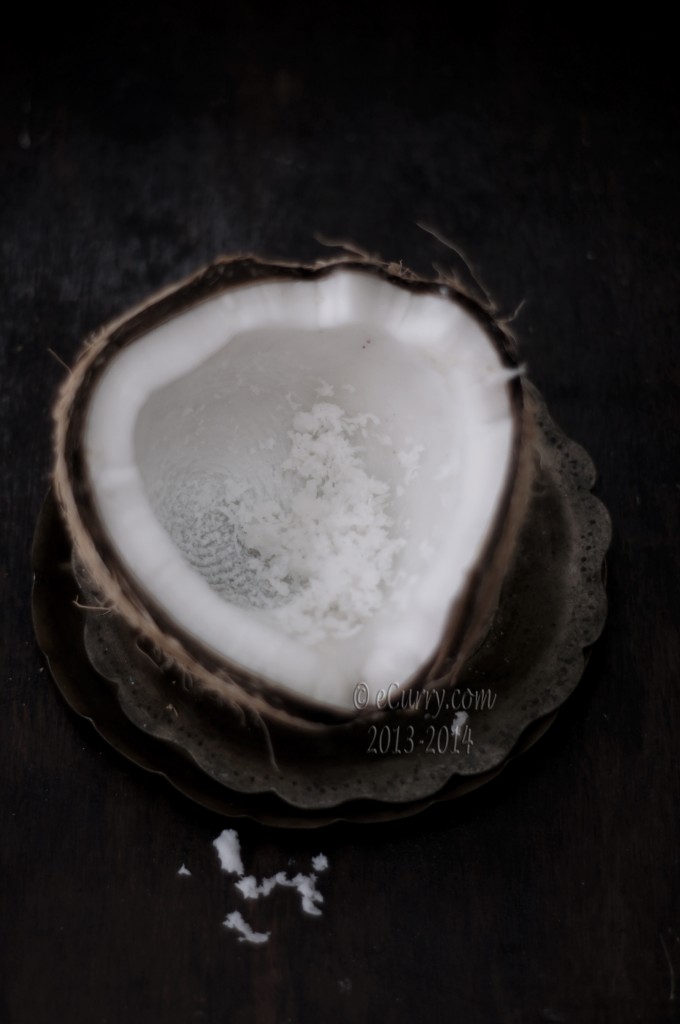
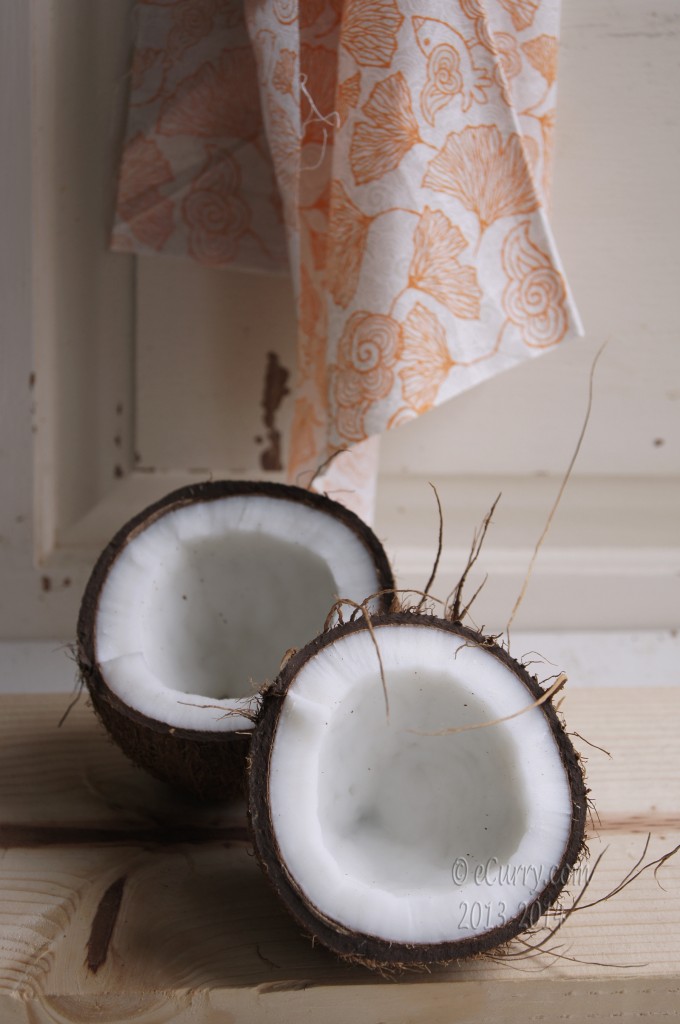
Coconut and every part of the tree too, are used in innumerable ways around the world. I used to be told when I was little, that not just the nut (actually a drupe), but the coconut tree is indeed God’s gift to mankind; it is a “tree of thousand uses”. In India coconut is used for worship. A whole coconut is also “broken” to mark a new beginning in life – a new job, a new home….
The botanical name of coconut is Cocos Nucifera; cocos meaning grinning face and nucifera is bearing nuts. Sure they look like little grinning monkeys to me.
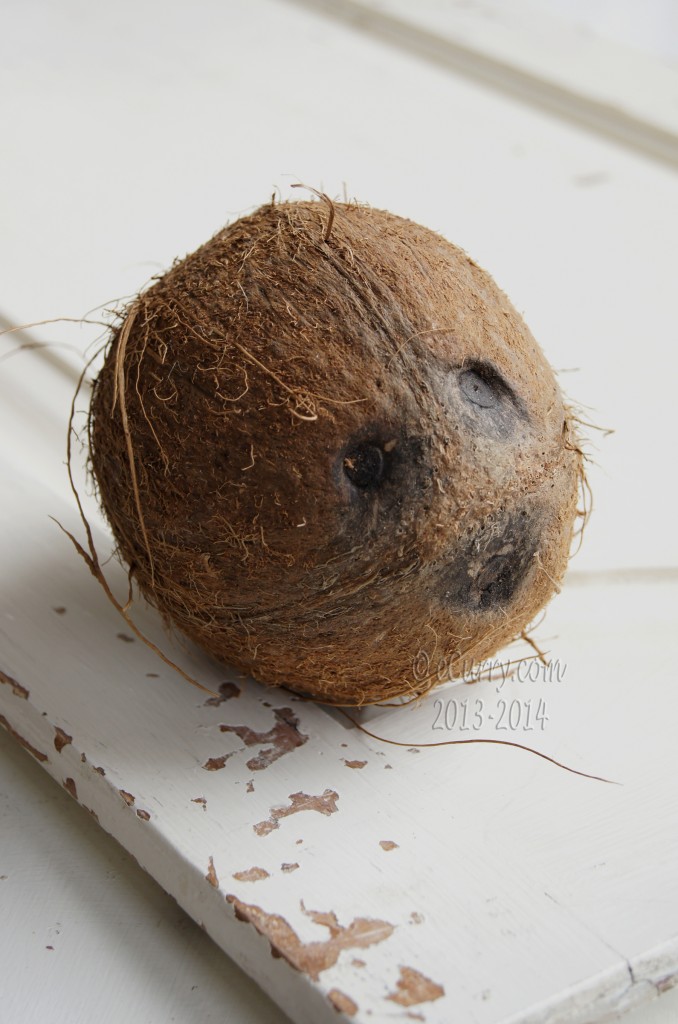
While the market shelves are packed with canned and bagged coconut milk, shredded, grated, frozen and dried coconuts, a lot of us have not grown up with ready and processed products. All I knew was that when a coconut comes home, I will get to drink the juice (if it is good) and have a whole lot of sliced or finely white sweet flesh – even before the cooking started. My grandpa would patiently slice off the flesh from one half, while my grandma worked on the other half, grating it with a manual machine…
…similar to this one.
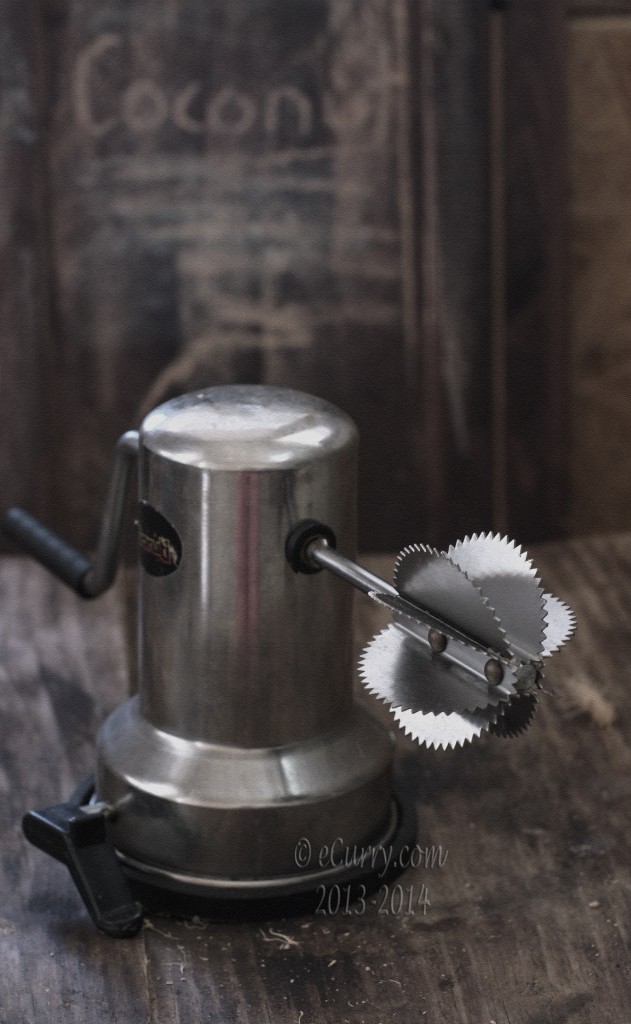
The white pile of coconut that got grated on the plate looked as beautiful as the first snowfall. It still makes me reach out for a scoop of the sweet tenderness.
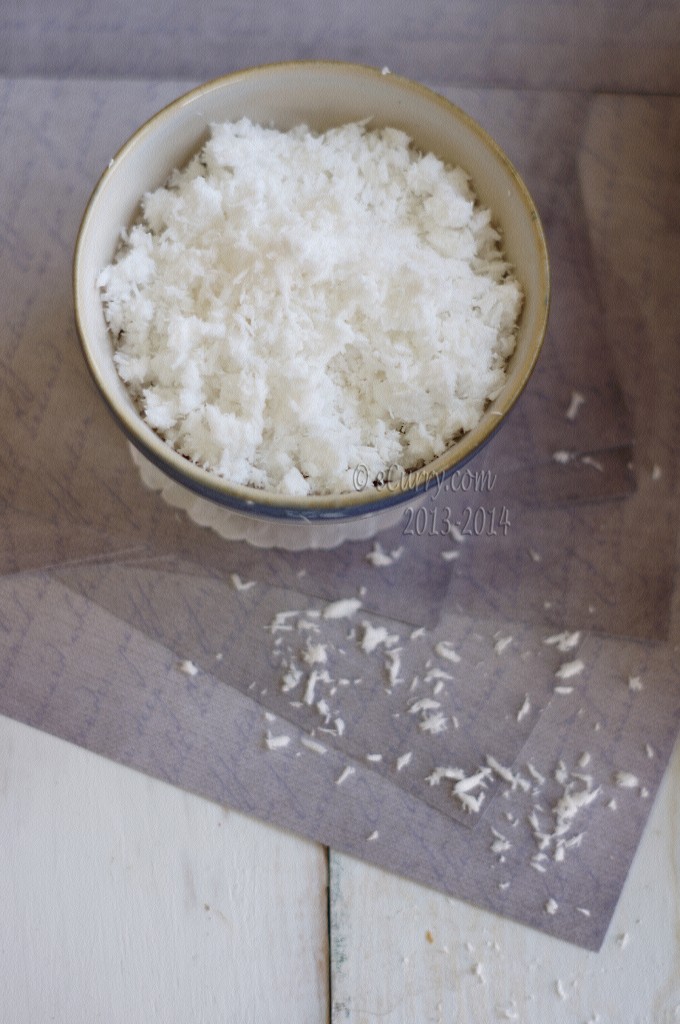
Though not often, but I still get fresh coconut and do the basic processing at home to cook with. When I see a coconut piled up in the aisle and get that sudden urge to sip the sweet juice from it or slice out the white flesh to munch on and I do get one home.
Did you know that the brown ones that we usually use for cooking and extracting coconut milk is the ripened coconut? The juice is clear and sweet and the flesh is tough… tougher than the green coconut. The green coconut has tender, almost transparent sweet and jelly like flesh inside them. They are divine! In the streets of India, the water satiates a thirsty traveler in the heat of the summer and then the street side vendor will split the green coconut for you, to reveal the soft flesh that may be scooped out and relished.
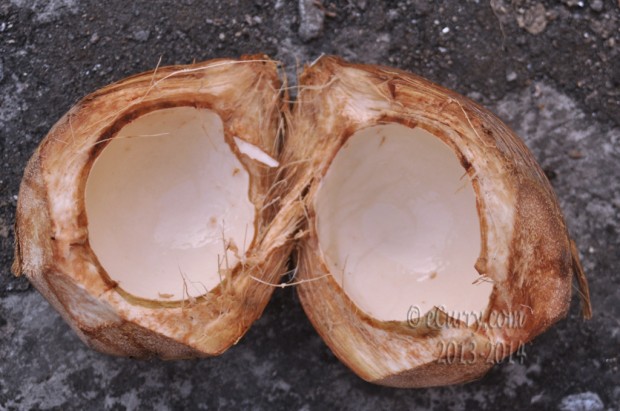
photo courtesy: my dad
I am aware that the need to process a coconut at home is disappearing. It is time consuming and hard work, especially when everything we need it is available already. But I see it as a lost art and there will be always someone somewhere wanting to do it all from scratch. Besides you may get the frozen grated coconut in the bags, but nothing will ever satisfy you like having a cold glass of clear and sweet coconut juice.
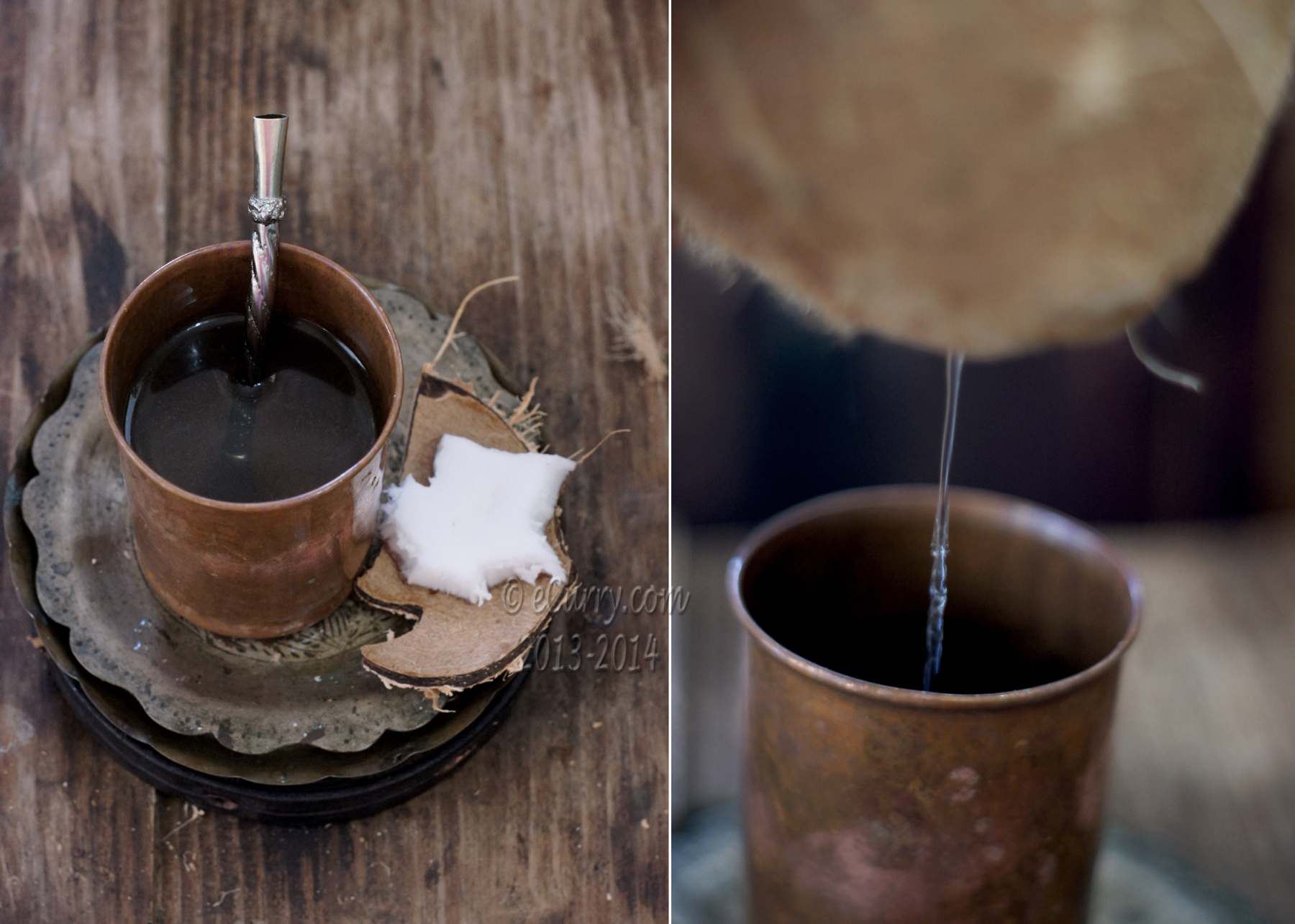
“He who plants a coconut tree, plants food and drink, vessels and clothing, a home for himself and a heritage for his children”. (source unknown). The everyday uses are more than one can count; so true to the saying “If you could count the stars, then you could count all the ways the coconut tree serves us” (a proverb from Philippine)
The trees can grow up to hundred feet tall and produces thousands of coconut in its lifetime.
It is known as the “Tree of Life”.
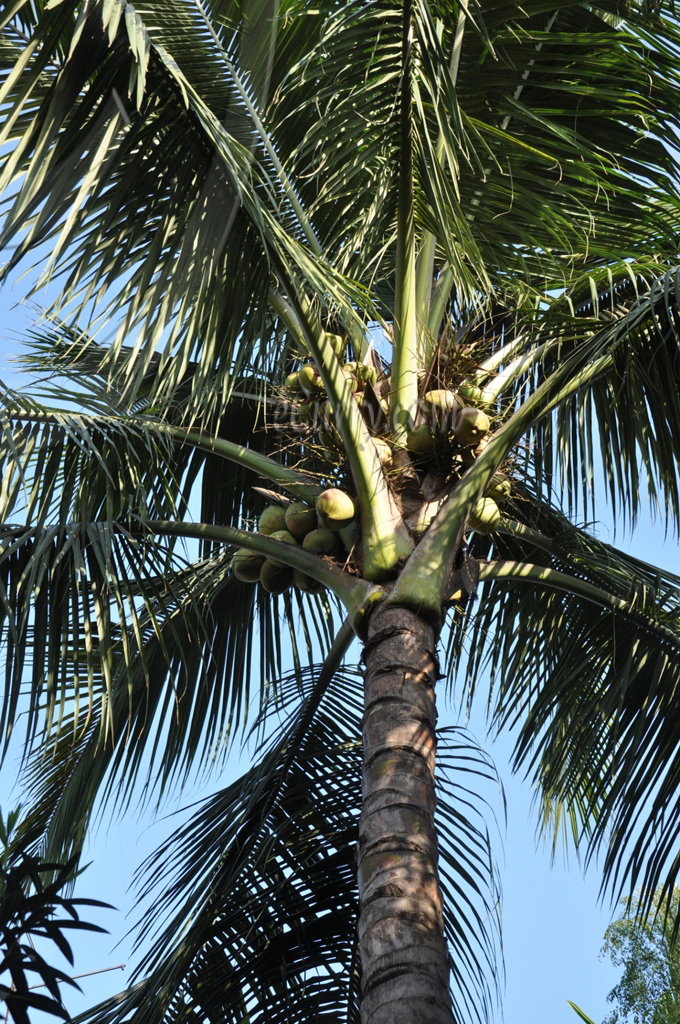
photo courtesy: my dad
Back home life revolved around everything coconut; the flesh, the shell, milk, coconut oil, rugs braided with coconut coir, coir mats and mattresses, brooms, sacks, bags, twines and cords, and sitting under the tall tall trees and playing with my friends. (I have to admit that I used to be afraid that a coconut would fall and bounce of our head. The incident is not unheard of!).
I miss the sweet juice of green coconut which we sipped with a straw on the roadside to beat the heat of summer and as well to soothe a tender stomach.
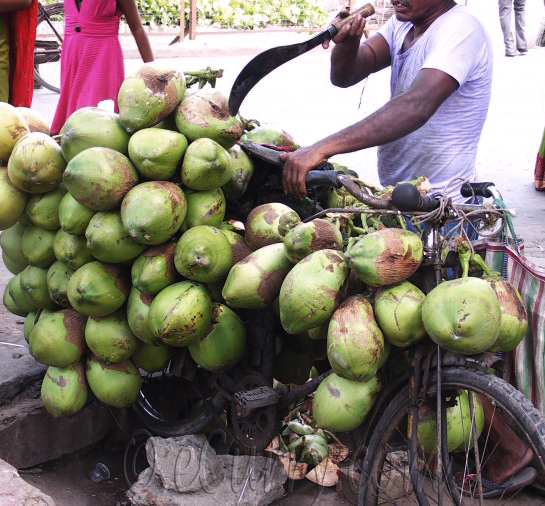

I had written this post a couple years back; it is time to get it out of my draft folder now. We will see how to crack a coconut without too much effort or without making much of a mess and also go through how to remove the flesh and process it to some extent.
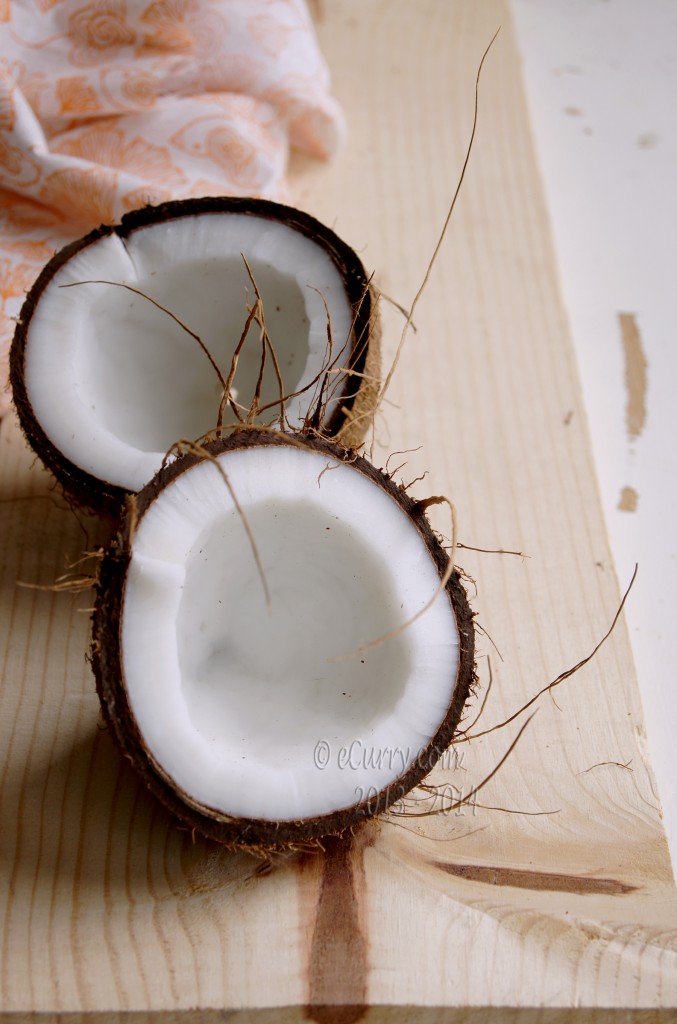
Let us start on it now!
There are three “eyes” at one end of the coconut. One of the eyes is soft and can be pierced in with anything sharp: skewer, screwdriver, ice pick etc. This is the eye from where the germinated seed begins growing and eventually the new plant will pierce through. First find the soft eye. Then with the pointed end of any tool you choose to use, (you should be able to poke through it, while the other two will be hard) slowly drill/poke through it and clear it up.
Hold a glass over this eye area and carefully turn over the coconut over the glass. Let the juice drain out. Keep in mind that this is not the coconut milk.
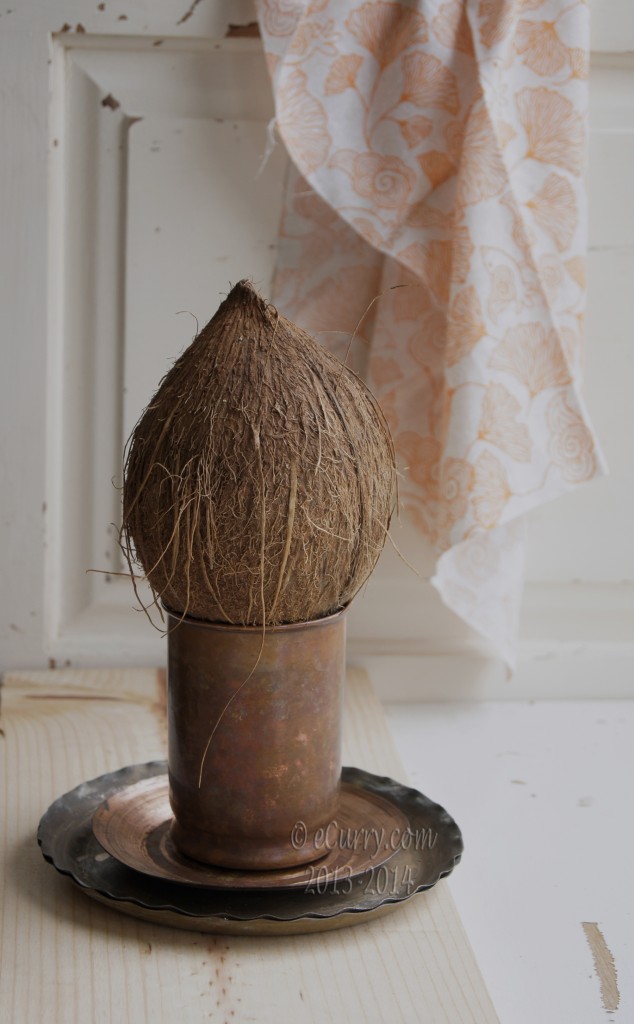
Drink it!
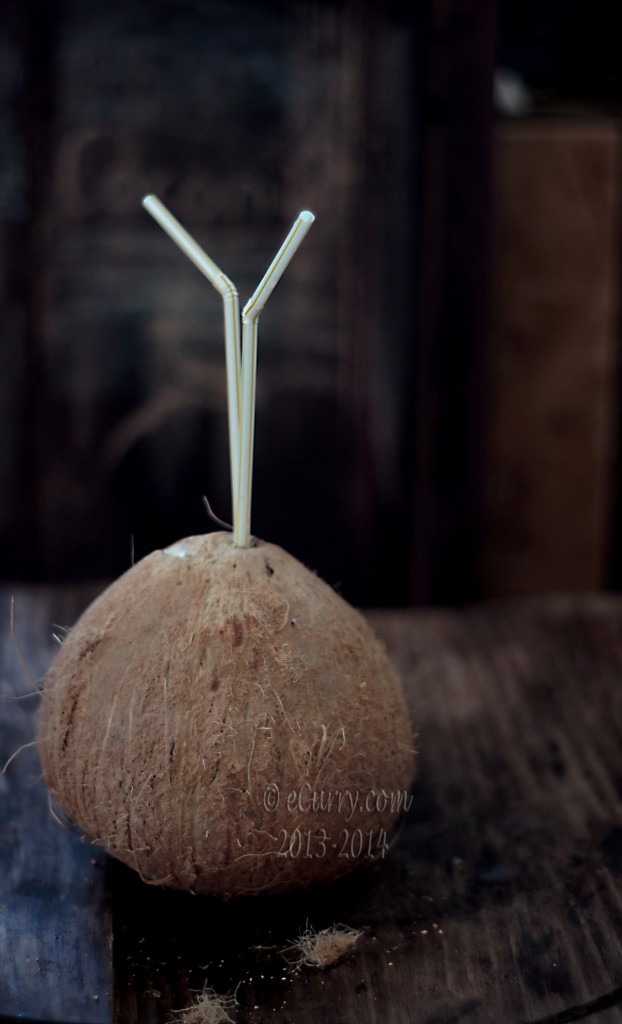
It is refreshing and really wonderful. Or save it to use in cooking/drinks/smoothie. If the water tastes not so fresh and has an oily and stale smell, the chances are you have to start over again. The coconut is old and has gone bad. The flesh will have a similar “stench” too. If this happens, you will have to toss this coconut and start fresh with another one, maybe another day.
Cracking open a Coconut:
Method 1 (Manual):
After the juice is completely drained, hold the coconut with one hand with a solid grip and with the blunt edge of a big and heavy knife or a hammer, firmly tap around the “equator” (the imaginary line that separates the 2 halves of the coconut horizontally) of the coconut, while slowly turning/rotating the coconut around. Continue tapping it around until you see it split. It might not split in exact halves. You are lucky if it does.
(Now hold the coconut and smash/crash it on the floor or concrete…Just kidding! But it is a way and I have done that a few times, when I lose the patience tap, tapping it all around.)
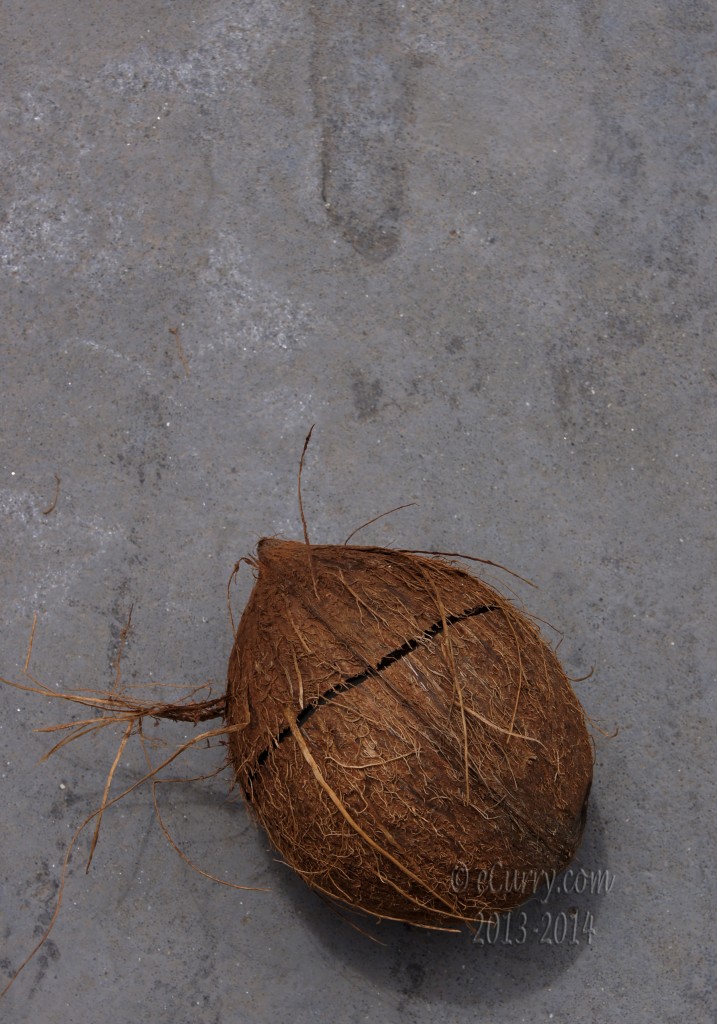
Once the split is there, it will crack open soon. Keep tapping along the split/crack until it opens up.
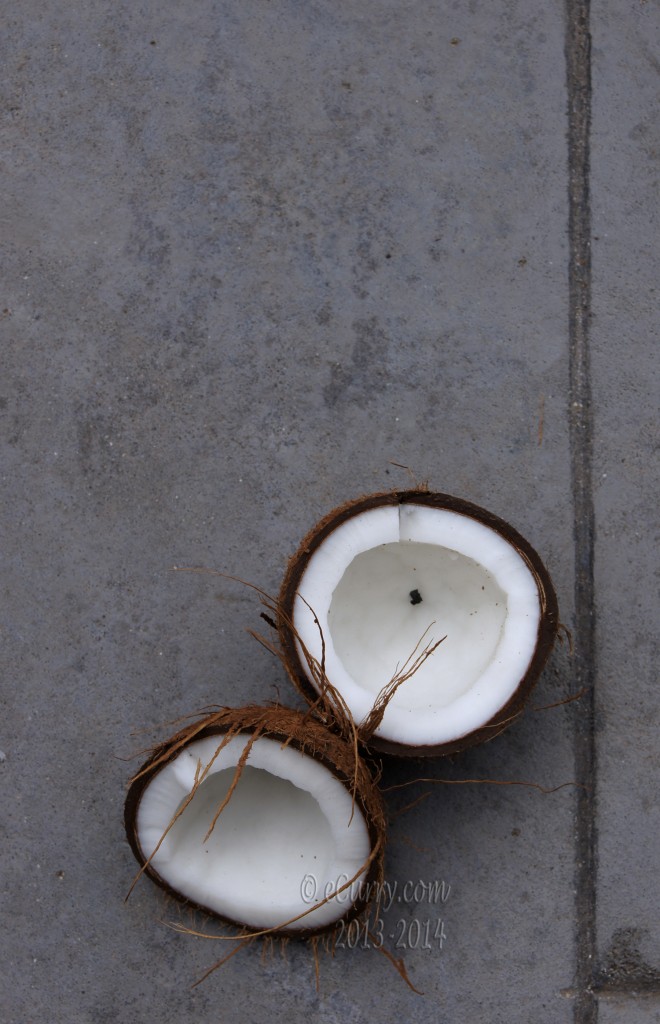
Method 2 (Using an Oven):
After all the water has been drained, place the coconut in the oven at 350 F for about 10 – 15 minutes. Once done, you will see the faint splits around the coconut, and it may be opened by using a hammer. Gently tap and it will split open.
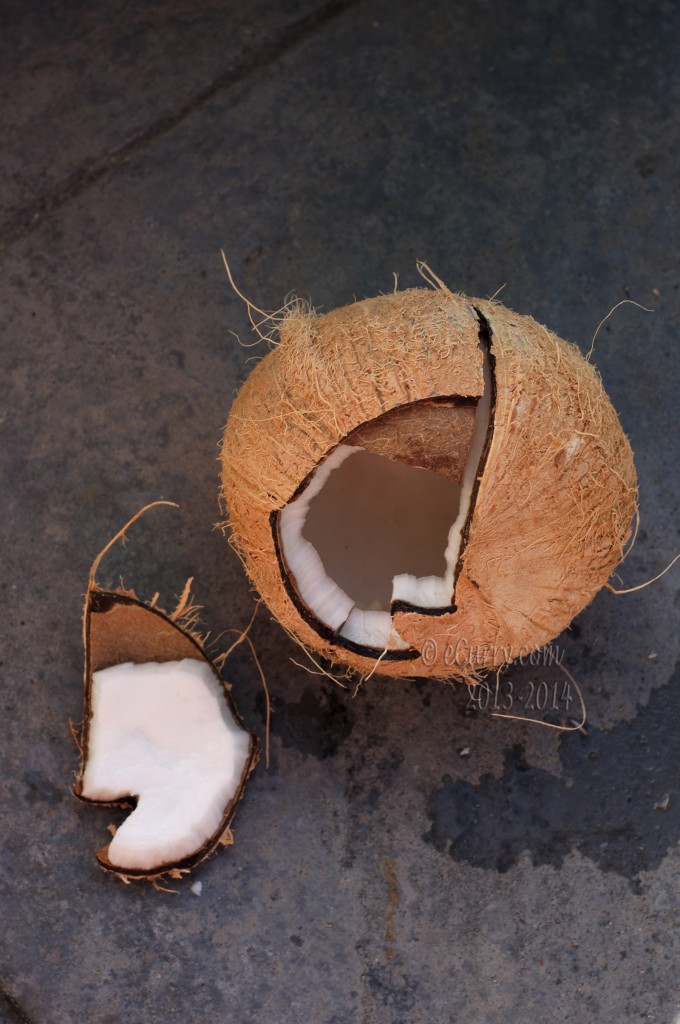
Removing the flesh from the coconut:
If you have used the oven to crack your coconut, you are a step ahead. The heat loosens the shell, and if at one corner, you slide in the end of a spoon or a fork and give it slight lift, the flesh will come away from the shell quite easily. There is a chance that the entire flesh from each half might loosen and come off looking like bowls, but sometimes they will also come out in pieces.
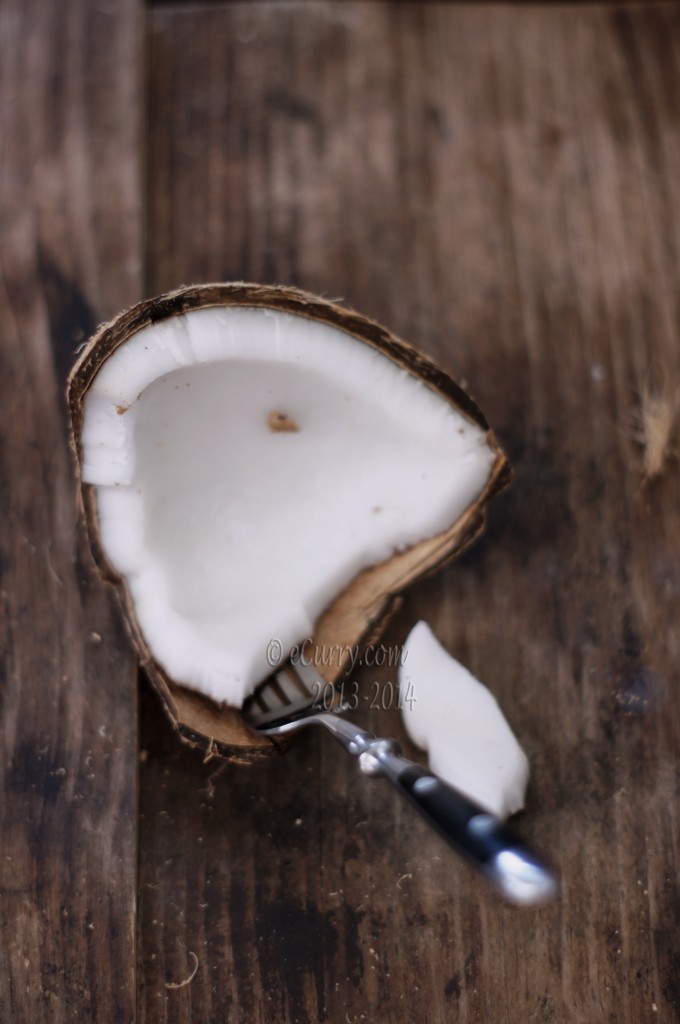
If you have not baked the Coconut to open it:
Loosely wrap the broken parts with the flesh with a foil and bake at 350 F for about 10-15 minutes. Carefully remove it and loosen the flesh by sliding in the end of the spoon and lifting the flesh away from the shell. It should come off pretty easily.
Using a knife: slicing the flesh
Holding one half of the coconut, you may slowly slice off the flesh with a knife. I still love munching off slices of coconut. If you want to remove the brown skin, simply peel it off with a peeler or knife. (See below)
Using a Coconut grater: grating Coconut flesh
I have grown up seeing my grand moms and my maa using the mechanical coconut graters. There are several kinds available depending on which part of India one hails from. My grandma had one which sat on a flat surface, with a grater wheel on one side and a rotating handle on the other side. One would have to hold the coconut half tightly on the grater wheel, while the other hand was used to rotate the handle. This would make the grater wheel turn around and scrape out the coconut flesh.
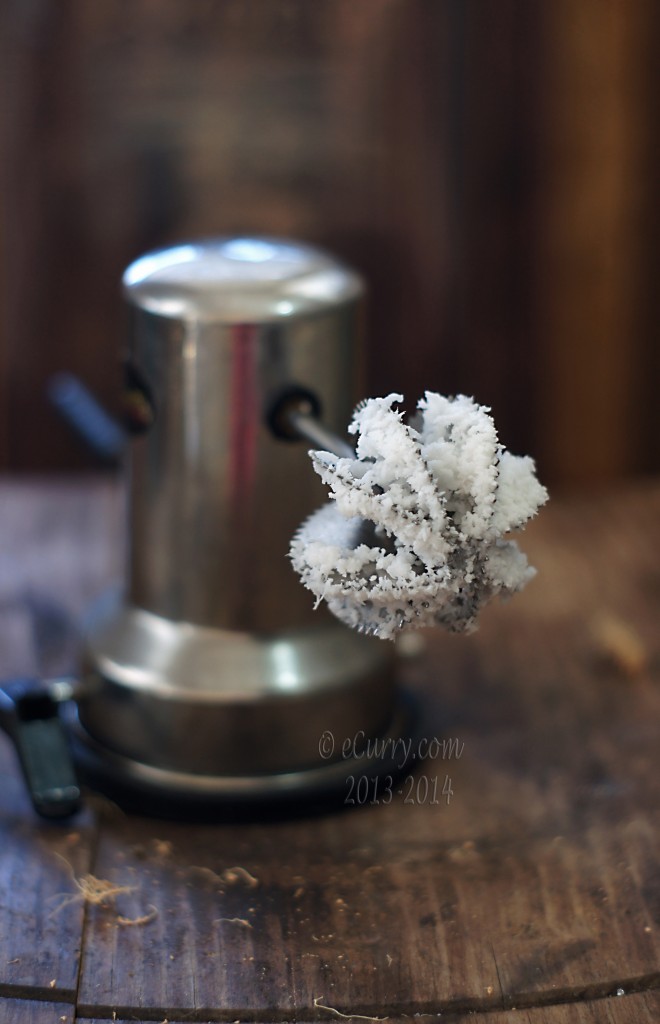
My maa had one where it had a scraper and one would have to hold the coconut half and actually scrape the flesh against the grater (teeth) and that would scrape out the flesh.
And then there is a small hand held manual grater (which I seem to have misplaced. I will update with a photograph once I find it). This is tedious to use, but works if you are to scrape out only a little bit of the flesh.
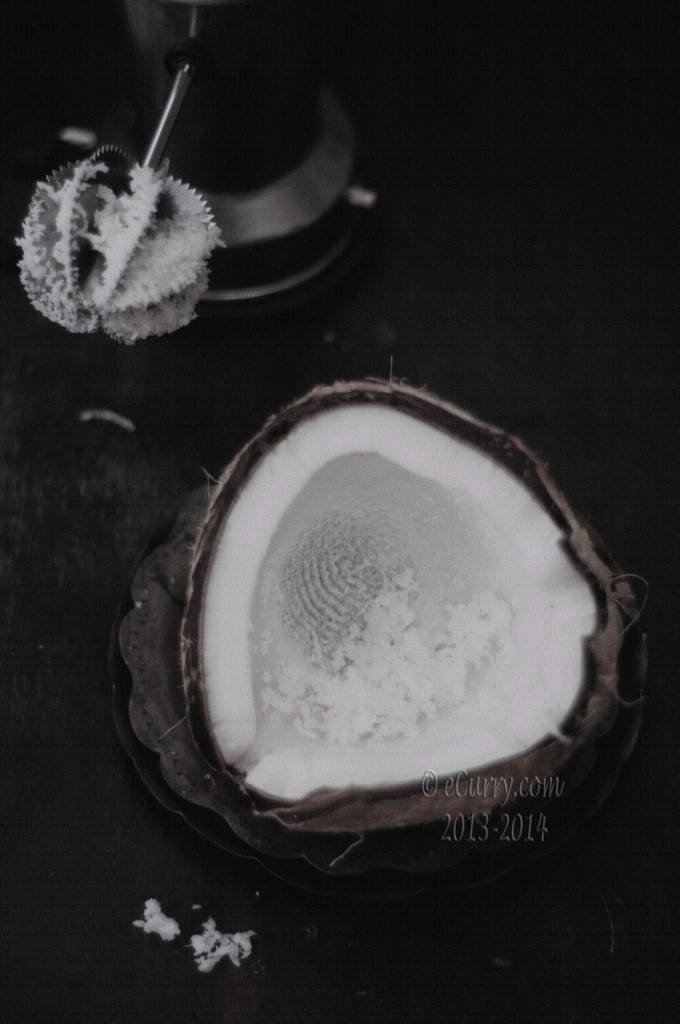
If you have a food processor, remove the flesh from the shell, (peel the brown off if you want to** ) and just process the flesh (grate or shred) them in the food processor with the appropriate attachment. You have to be careful here not to process it too much or too long, or else you will have the coconut milk and the oil release from the flesh.
**Peeling the “brown” off:
The brown peel is edible, but if you want to remove it, you can use a potato/vegetable peeler to peel it off.
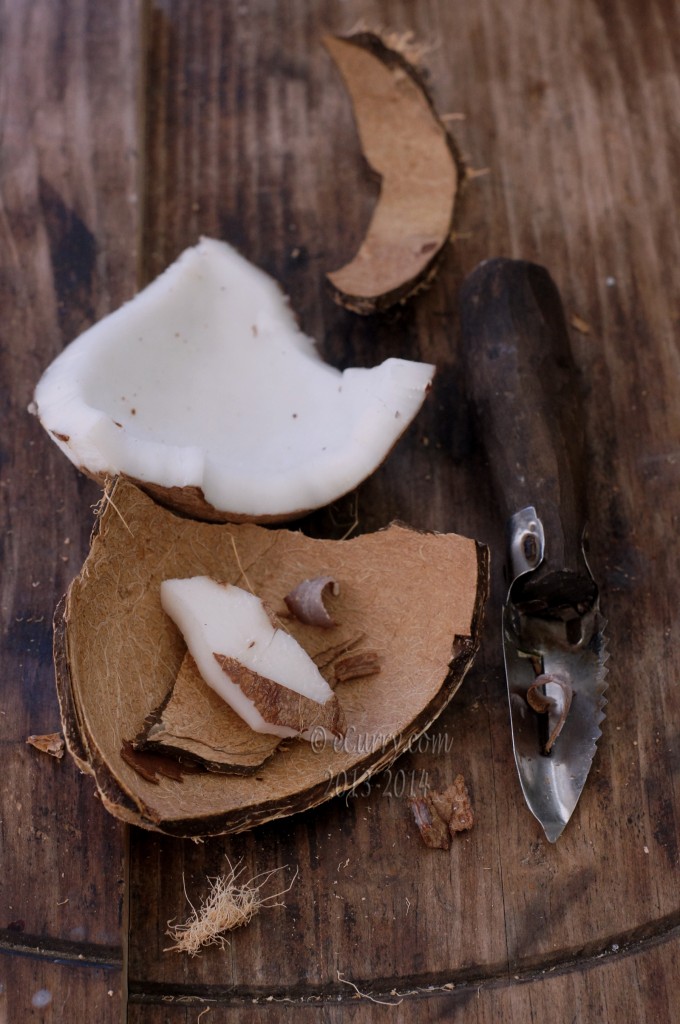
This post is only part of the Coconut story. I will make another post on how to make coconut milk.
More Homemade Indian Basics :
- Curry Sauce
- Chili Garlic Paste
- Garam Masala
- Ghee
- Homemade: Chaat Masala
- Homemade: Ginger and Garlic Pastes


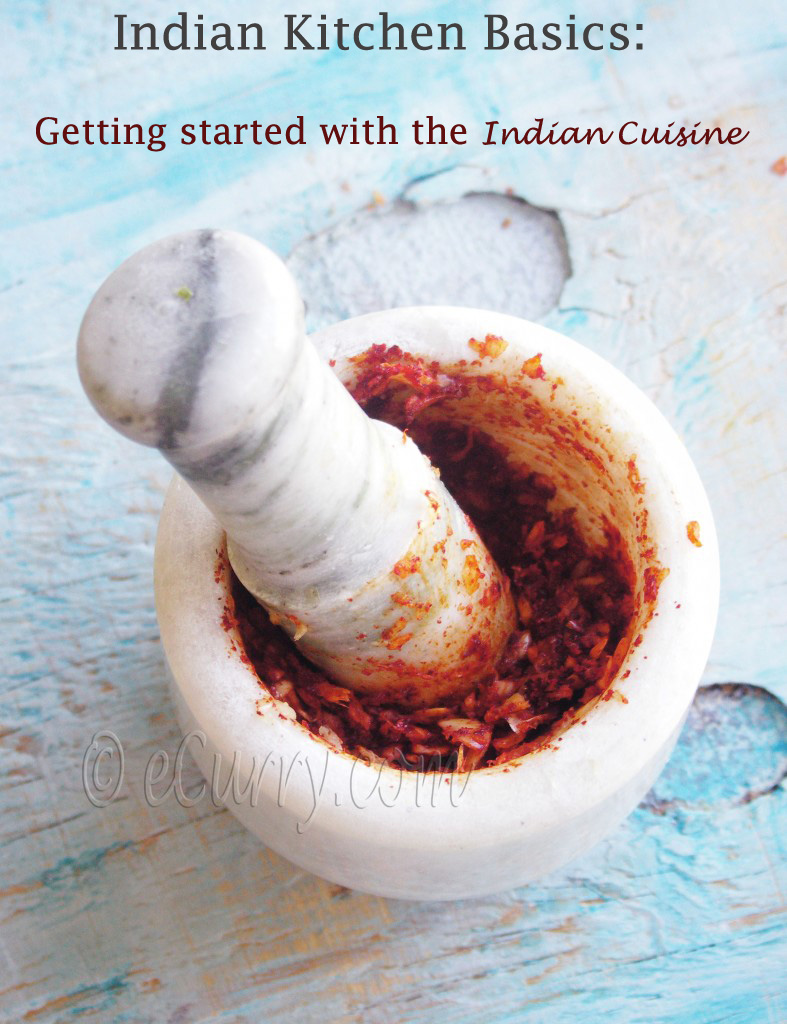
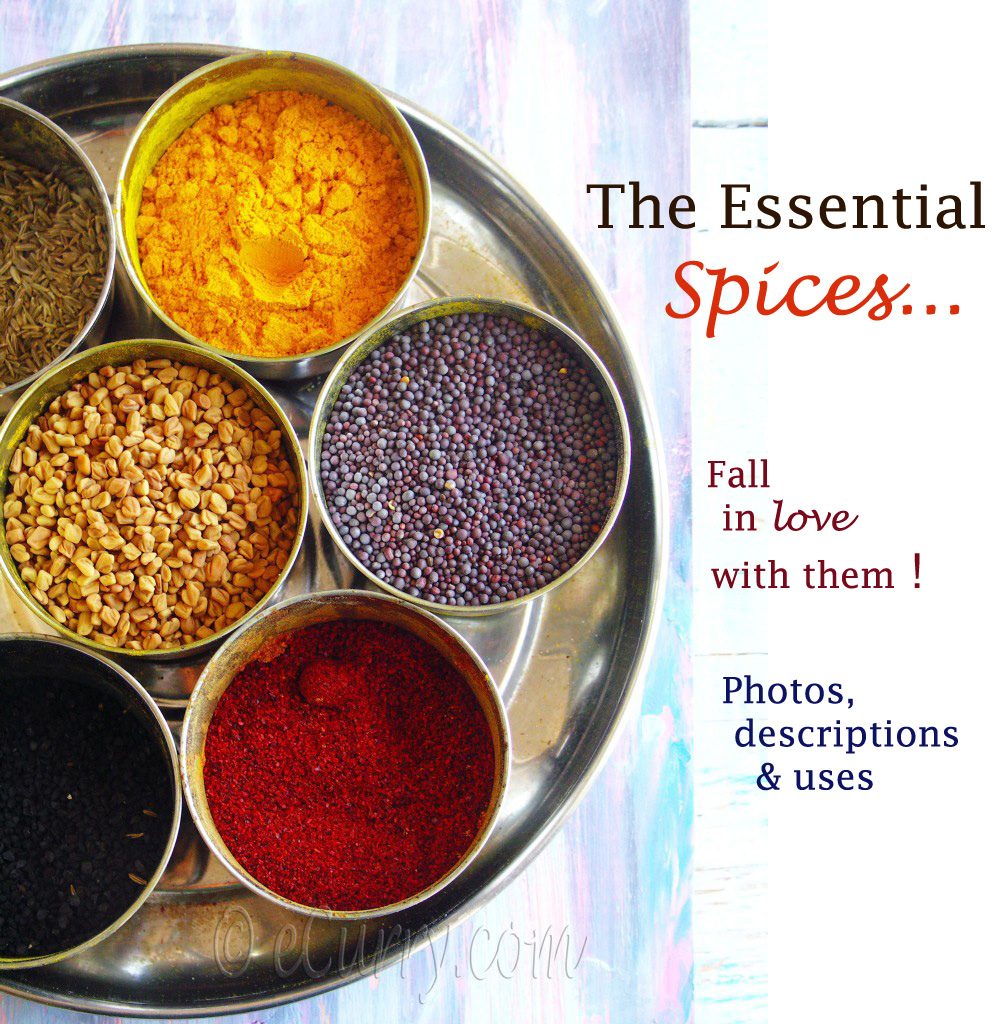








Aaahhh, wonderful! I am very fond of coconuts and naything coconutty. That is an interesting machine.
Great clicks, as always.
Cheers,
Rosa
My dadu used to plant one coconut tree for every grand child born. We have a big family, and my dadu’s house is full with coconut trees all over. Looking at your pics made me homesick :(.
After coming to the US, I have almost forgotten the taste of cocont water and fresh cut coconuts. Oh I loved it so much.
ahhh…loved this post…so nostalgic and brought back so many memories…though I dint grow up in India, my parents always broke open and grated fresh coconut themselves…we never used frozen or store bought varities…
But I’m lazy n I use dry coconut powder for most of my cooking…but recently we had a pooja at home and had to crack open some coconut and ate the fresh flesh after a long time and it tasted heavenly and I thoguht I should do a post on it…mayb i will 🙂
I’m so glad u brought this out of ur drafts 🙂 n ur dad takes good snaps!
Lovely post.
I never buy frozen coconut. I used to buy canned milk for Thai coconut soup, but not anymore. My friends think I’m crazy to grate coconut in the US, but who cares? Couple of my friends told me they use cow’s milk for curries, yikes!!!!! (I love cow’s milk, not for curries) for me there is not substitute for coconut (milk), period. Thankfully, I can get fresh coconuts where I live.
Have you tried coconut water with lime juice of half a lime and a spoonful of honey (optional)? it’s so good, and refreshing.
Lovely post soma. . Brought back so many memories .. very informative post… baking the coconut seems very new n easy method. . Thanks once again.. Its mid-night here,now I am feeling to hv fresh tender coconut water to quench my thirst in this hot summer. Beautiful pics..
…gorgeous!
I also wish that we here in the U.S. could get the coconut flower – so sweet.
I have one of those wooden planks with the barbed end too. Frozen coconut flesh sounds so odd. And the juice out of a can isn’t very good, never as delicately sweet as the fresh stuff.
Ahh the comforting feeling of reading about something we take for granted. Thank you Soma for the lovely pictorial!
Love cracking coconuts open the traditional way even now.. The trick is to completely drench the coconut before tapping on the equator with the hammer just so that the woody shell does not shatter..
I loved this! I never appreciated coconuts until I moved to Southeast Asia, but it’s true that I’ve never had so many delicious variations until I went to India. Beautiful photos.
Growing up in a punjabi household we never ate anything with coconut in it except Sweets. But being married to a maharastrian Coconut is now a part of my diet and I cook frequently with it. Love this post.
Nice! I had forgotten the oven method. It’s always a bit of struggle to remove the flesh from the shell. I will replace the habit of using a knife (which always slips) with spoon or fork, as you suggest.
lovely post. I always let hubby take care of opening the coconut, he uses a hammer too but with this knowledge now I might give it a try too. Thanks a ton for this, Soma!
Soma, your photos bring everything to life….
cheers,
d
This is a perfect coconut story! I got a grater very much like yours at the Indian grocery store here in California, and grated a big bag that I keep in the freezer. I saw that cracking method in a video , and combined with the grater, it makes up for all the wasted energy of past years. Can’t wait for the next installment!
a very interesting post Soma, I always love and look for such kitchen/home basics post. & this surely is a keeper. I have a half cracked coconut in kitchen, half due to a fall on the concrete floor. Now I know, what needs to be done.
BTW Soma, what is the shelf life of home made coconut milk?
Love your story and your grater, S!
Soma, This is so exciting, especially for those who are crazy about coconut! It brings back memories of when I visited India and we bought coconuts on the street to drink the cool juice.. Mmmmm!Thanks.
Lovly post Soma and even lovlier clicks….I am always the one to crack open the coconut in my home. it does need a little manoeuvring and some deftness of hand! We had 5 coconut trees in my ancestral home and dad always used to call the gardener on a lazy sunday and get him to pluck out the coconuts and we would have tender coconuts all day…
Shobha
I, too, love coconuts. I was especially touched by all your and your commenters made about home. Home is truly where our hearts live, no matter where our bodies and daily lives are. Home is special foods, the view from the front porch, hopefully the essence of love given to us. We always miss it and when we can return, our hearts run ahead of us to claim it once again!
Very informative post.
This post truely shows that how important are the basic things in life.
I’m fortunate to have ripe coconuts always at hand, though fresh ones are hard to come by.
I love coconut water…and did you know that it was used as glucose once when medical aid was not available on time to the needy. its osmolarity is perfect for the body.
I never knew about the soft eye. Will try that and get to the coconut water. Always lose some when I break it open. Nice pics.
Wow, sometimes it takes a post like this to appreciate the things you have. I have about 20 coconut trees in my garden. Sadly I am not as civilized as you are about opening the dry nuts.I just throw them onto my concrete pathway and pick up the piecs;-)
Haha…my method is smashing it on the hard floor…everytime. I like it that way. I use the traditional Bengali coconut grater.
When we honeymooned in Tahiti, my husband learned how to crack open coconuts. 🙂 Nothing is better than fresh.
Well, well, this could well be one of my favourite posts in your blog (till you start cooking some mustard fish and photograph it in your black kada and khunti lying beside!). It’s simple, basic yet important coz many of us don’t know such a basic thing as breaking a coconut open or to ‘kudo’the inner flesh. I wish you could bring a traditional bengali boti with kudoni too!
Coming from a household where coconuts was a way of life, I relate to this post of yours. I am glad you rescued this one from your drafts and did such a splendid job of writing about this miraculous fruit.
Enjoyed this post!
eagerly waiting for the coconut milk post…:)
psst..i have 4 coconuts in my home and i’m scratching my head for ideas
i would like to buy a three eyes coconut, where can i get it?
thanks
All coconuts have 3 eyes! only one of them will be soft!